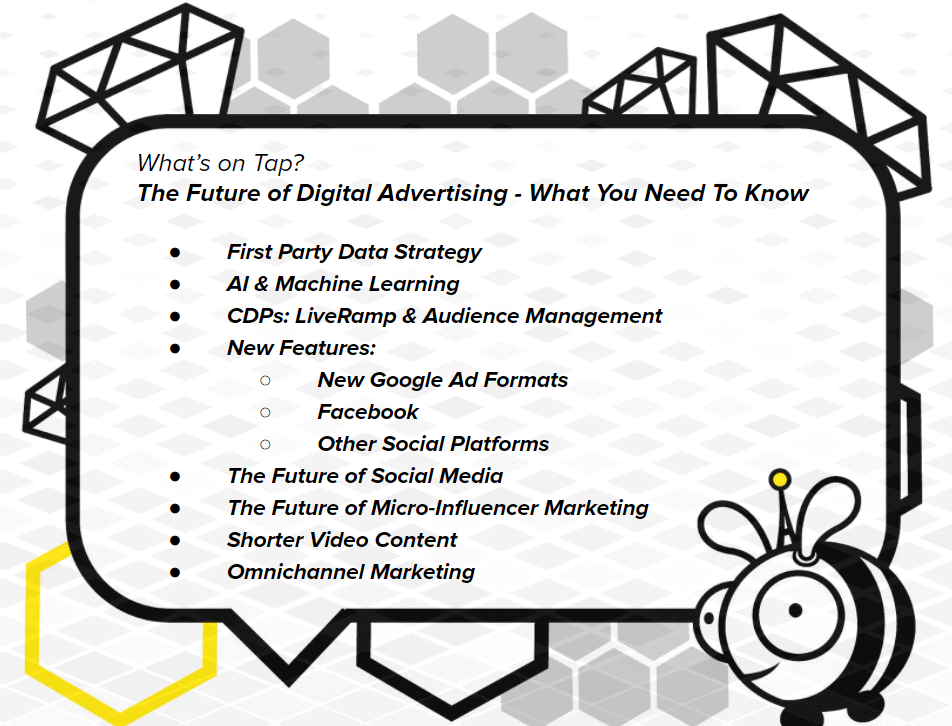Podcast: Play in new window | Download
Subscribe: RSS
We are in the middle of a significant evolutionary jump in the world of Digital Advertising.
There has already been a battle with Ad Blockers, Apple’s Intelligent Tracking Prevention, App Tracking Transparency, and changing regulations regarding data privacy.
With Google’s announcement that it would phase out third-party cookies in Chrome within two years, Advertisers took another hit.
So is this the end of Digital Advertising as we know it?
Not. Even. Close.
Digital Advertising will have to change, become more innovative, and proactively be relevant to consumers to deliver ROI to advertisers.
Let’s dive in and break down what’s coming for the future of digital advertising.
What’s working?

AI & Machine Learning
We often think of AI as self-driving cars and creepy bots. In reality, AI is made up of hundreds of tools and apps that operate all around us – right now.

These behind-the-scenes tools are making our lives simpler with automated tasks. You can expect to see:
- Targeted marketing
- AI-Driven Content Marketing
- AI in CRM
- Identifying Audiences with AI Tools & Platforms
First-Party Data Strategy
Most brands aren’t yet harnessing first-party data’s full potential despite its apparent benefits. It’s time to put first-party data strategy front and center!

Five ways to start collecting first-party data:
- Tailor to customer objectives
- Offer value in exchange for data
- Invest in tech and organizational enablers
- Test and learn to determine activation
- Refine and validate with measurement
Customer Data Platforms & Audience Management
- Audience management tools are the primary need to get an insight into your customer.
- Few audience manager platforms to consider –
- LiveRamp
- Segment.com
- Lotame
- Salesforce DMP

New Google Ads Features and Formats
- Google is updating Smart Shopping and Local campaign to Performance Max Campaigns.
- Performance Max uses Google’s automation to help advertisers reach shoppers by browsing for things they love — online and in stores.
- You can reach users on YouTube, Gmail, Search Network through one campaign.

Google’ Privacy Sandbox
Google is updating its platform to accommodate changes to third-party cookies with a set of application programming interfaces (APIs); this includes FLoC, SPARROW, Turtledove, FLEDGE, and Dovekey. Advertisers can use these to:
- The prevention of spam, fraud, and DoS
- Conversions
- Ad targeting
- Attribution
- Federated logins

Google PPIDs
The Publisher Provided IDentifier (PPID) allows publishers to send Google Ads Manager an identifier for use in:
- Frequency capping
- Audience segmentation and targeting
- Sequential ad rotation
- Audience-based ad delivery controls across devices
PPIDs are based on your first-party data; they won’t be affected by the third-party cookie deprecation.

Social Platform Updates Due to Change in Apple’s IDFA
Social Media Advertising Platforms such as Tik Tok, Pinterest, Snapchat had to update the following to adjust to the reject changes by Apple
- Target iOS 14.5 users for app install ads will be through iOS 14 dedicated campaigns
- Update your Mobile Measurement Partner SDK
- Send all events to the platform via MMP
- Complete the Conversion event configuration in their MMP interface

New Updates: Facebook / Meta
- iOS 14 Updates: Meta is constantly updating its policies to meet iOS requirements and all other platforms that use third party cookies
- Domain Verification
- Track Up to 8 Unique Events
- Conversion API
- Facebook has been and will continue removing some of the Detailed Targeting options such as sexual orientation, religious practices & groups, political beliefs and so on.

The Future of Social Media
Some of the new ways that social networks are going to help us reach audiences:
- Video remains a prominent format
- Continued pushing of authentic content
- More of a focus on live streaming and live shopping
- Automating social ad production

Omni-Channel Marketing
Omni-channel marketing is the integration and cooperation of the various channels used to interact with consumers, to create a consistent brand experience.
Third-party analytics such as segment.io and Kochava (mobile) enable Omni-channel marketing with First-Party Data.

Shorter Video Content
Shorter video content is becoming increasingly popular for several reasons:
- Easy to digest
- Higher levels of engagement
- Easily shareable
- Allows creators to be innovative
- Budget-friendly
- Enables authenticity
With the growth of shorter video content, social media platforms have altered their algorithms to favour it; this is something that marketers can take advantage of when creating content.

Final Word
It’s a fact that 3rd party cookie data and identifiers are going away.
Businesses and Advertisers have to adapt to the changes as quickly as possible to achieve their marketing goals.
First-Party data is the future of digital advertising.

We hope you enjoyed learning about The Future of Digital Advertising. If you’re looking for more great content, check out some of our other reads below:
Shoppable Livestreams for Ecommerce
How to Make Content that Drives Conversions and Leads
Driving Content Engagement With Video and Humour

